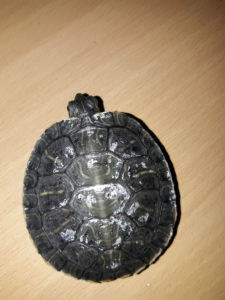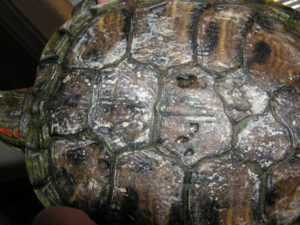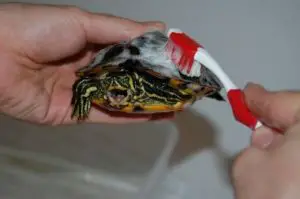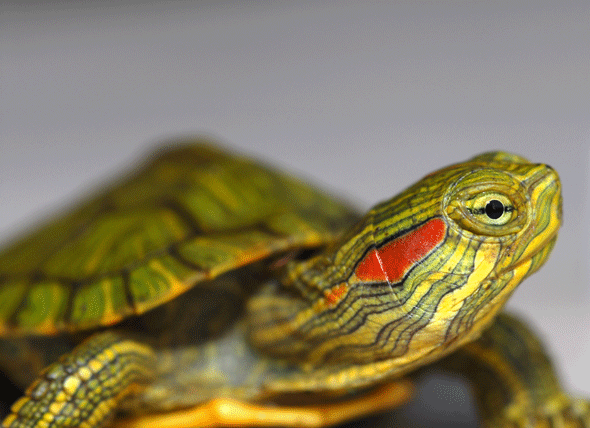Keeping pet turtles is such a satisfying thing to do, there is just something majestic about watching them and taking care of them. Over time you can build real bonds as you slowly learn about your turtles personality and it’s own characteristics. How to treat turtle shell rot.
So with that in mind it can be absolutely heartbreaking to see that your turtle is suffering from a case of turtle shell rot. Believe it or not turtle shell rot is actually more common than you would believe. Fortunately it is quite easy to treat and in this guide we will show you exactly how.
You may also want to know what the top 10 common bearded dragon keeping mistakes are.
Not only that either, we are also going to tell you why it happens in the first place and how it can be stopped from happening altogether. So grab a drink and get ready to read because if you keep turtles this guide is going to come in handy for you!
What causes turtle shell rot?
First things first let’s find out why your turtle is suffering from shell rot.
Below is a list of reasons why your turtle may get shell rot:
- Semi aquatic turtles may get shell rot if they do not have an area in their enclosure to dry out. These types of turtles need areas to be able to bask or heat up which in turn drys out their shells.
- Terrestrial turtles may get shell rot if they are in an environment that is either to damp or to humid. Their shells are not designed to be in that atmosphere.
When a turtles shell gets wet and does not get the chance to dry out. The dampness of the shell allows bacteria to build up which then in turn actively rots away the turtles shell.
If the shell rot is not treated or not treated properly things can get serious very quickly. The bacteria can cause infections that lead to organ failure and ultimately death. This is why it is very important to treat shell rot as soon as possible and to also reduce the chances of it happening in the first place.

Treat turtle shell rot.
Which species of turtle can get shell rot?
There are quite a few species of turtle that may suffer from turtle shell rot, I will list them below. Read here 6 tiny turtles that make great pets.
Aquatic turtles that can suffer from shell rot:
- Bog turtle
- Wood turtle
- Mud turtle
- Chicken turtle
- Spotted turtle
- Map turtle
- Slider turtle
Terrestrial turtles that can suffer from shell rot:
- Box turtle
- Tortoises
What does turtle shell rot look like.

Turtle shell rot often presents itself as a discoloration of the shell. Make sure you treat turtle shell rot.
Knowing what shell rot looks like is an important step in keeping your turtle healthy. Shell rot has a number of different symptoms depending on how severe or advanced the rot has become.
If the shell rot is not severe you should be able to notice some discoloration to the shell. Along with this it may feel a bit rougher than any neighbouring healthy shell. Last but not least there is a chance that the shell may feel softer in the effected area. This can be a sign that the shell rot is advancing.
Another symptom of shell rot is the pungent smell caused by the bacteria rotting the shell away.
In more severe cases of shell rot the shell itself may be totally rotten away revealing soft flesh and possibly puss. This is a serious case and can lead to serious health conditions and as such this needs to be treated by a specialist. Do not attempt to treat severe shell rot at home, instead seek immediate specialist help.

Turtle shell rot can cause pitting where the shell has rotten away.
How to treat turtle shell rot.
Ok so with all of the above being said we will now look at how to treat turtle shell rot. Treating it at home is really easy if you follow along with this guide, however there are some items that you will need to hand to treat it successfully. The items that you will need to treat shell rot are. So, how to treat turtle shell rot:
- Gentle/mild soap
- A soft nailbrush or toothbrush
- Betadine or povidone-iodine
- Gloves
- An old clean towel or paper towels to dry
The first thing to do when you have all of your items is to examine your turtle. Be very thorough and take note of all of the areas where shell rot is present, take your time as this is an important step, we do not want to miss any of the rot.
Once you have identified all areas that need treatment you can begin by taking your mild soap and brush and carefully and gently scrubbing at the rotten surface. Make sure not to get any of the soap onto your turtles skin as this can cause more harm than good. The aim of using the soap and brush is to clear away any stuck on dirt, and green algae that may have accumulated on the turtles shell. Once this is done you can rinse away all of the soap and debris with clean cool water.
The next step is to dry the turtle using your paper towels or clean dry towels. The drier that you can get the shell the better.
Now that the shell is clean it is time to kill off all of the bacteria that is causing the shell rot. To do this we use our pre bought chemicals, betadine or povidone-iodine and this can be applied a paper towel. You can also use your soft brush to make sure that the bacteria killing solution is really worked into all of the cracks in the shell. Take your time on this step and make sure yo get a good coverage over the shell rot area.
Once you have treated the shell you need to let the turtle dry out away from any source of water. Try to leave it for at least 20 minutes as this will allow the solution to soak in and dry up. The longer that you can keep the turtle dry the better the result will be.
You will need to repeat the process for a week or two and by this time you will see the recovery that your turtles shell has made.
Shell rot can easily make a return if the factors that caused it in the first place are not removed, so this next section of the article is going to tell you how to stop turtle shell rot from happening.

Clean your turtle with a mild and gentle soap using a soft brush
How to stop turtle rot from happening.
It is very important to take steps to ensure that your turtle does not suffer from shell rot. To reduce the chances significantly you need to make sure that any semi-aquatic turtles have areas in their enclosures that are dry. Areas where they can bask in warmth is important as this allows the shell to dry out when it gets damp and in turn this stops the build up of shell rotting bacteria from happening.
For terrestrial turtles it is important to make sure that their enclosure is not to damp or humid as this will also cause a damp shell and bacteria build up to occur.
In conclusion.
How to treat turtle shell rot? Shell rot in turtles is quite a common condition but is easily treated if caught early. It is even easier to stop from occurring in the first place as long as the proper steps are taken depending on the type of turtle that you own. I really hope that this guide has helped you treat your turtles shell rot without the need for an expensive trip to the vets.
